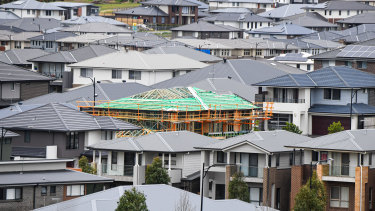Home buyers may not face more lending restrictions this year with top bank economists saying the regulator will likely sit tight amid prospects of an earlier than expected interest rate rise and signs of slowing property prices in Sydney and Melbourne.
Economists from AMP, Westpac, ANZ, the Commonwealth Bank and Bank of Queensland are cautious about the likelihood of more intervention from the Australian Prudential Regulation Authority this year amid rising speculation the Reserve Bank will increase interest rates as soon as August.

Bank economists say what happens next with the RBA is a significant factor in whether there will be more limits on lending.Credit:Peter Rae
In October, following two years of double-digit home price growth, the regulator introduced new rules requiring lenders to increase the interest rate against which they assess borrowers’ ability to repay their loan by 50 basis points.
However, Westpac economist Matthew Bunny said the regulator’s willingness to tighten the screws now “will hinge critically on when the Reserve Bank lifts the cash rate” off its current record low 0.1 per cent.
When the regulator last stepped in the central bank was still saying the cash rate would not be increased until 2024 at the earliest. A higher than expected inflation rate and a sharp drop in unemployment at the end of last year have raised the prospect of an increase in rates.
“We now expect the RBA will lift the cash rate in August this year,” Mr Bunny said. “Higher rates will inevitably take the steam out of the property market ... the RBA could steal APRA’s thunder.”
APRA chairman Wayne Byres indicated in November that if the market risked overheating and lending standards were not maintained, there was the potential for more limits stopping some borrowers from taking on too much debt. Mr Byres said rising interest rates could reduce the need for more intervention but said even if there was to be a small rise “they are still at historically very low levels and still facilitate very high levels of leverage”.
At the start of the year AMP Capital chief economist Shane Oliver said the chances of additional restrictions on lending stood at 50 per cent.
“Now it’s looking even less likely,” Dr Oliver said. “While investor lending has continued to surge, the [increases] in fixed mortgage rates (with more to come), the prospect of increasing variable rates sometime in the next six months and increasing signs that the property market is slowing down in Sydney and Melbourne suggest that further action is looking less likely,” he said.
“APRA will continue to sit tight for the next few months.”
NAB chief economist Alan Oster said the chances of intervention depend on the next few months and the strength in property values.
“We are expecting a relatively flat outcome this year and it could be, with talk of rate rises, [that] APRA will hold fire,” he said. “But if prices don’t flatten out soon then they will move in, say, two to three months time.”
ANZ head of Australian economics David Plank said last year the bank had considered macroprudential tightening to be very likely due to the strength of the housing market and implications for credit growth.
“The steps APRA eventually took in 2021 were in line with our thinking that the initial move would be relatively cautious,” he said.
This year, however, he said it depended on how the housing market performs.
“On that score we’ve highlighted that the rise in fixed mortgage rates is acting as a tightening of financial conditions, with the lowest interest rates on offer to home buyers quite a bit higher than they were. There is evidence that this has worked to slow down house price gains at least somewhat,” he said. “If the housing market continues to show some moderation in the months ahead then we think there is a very good chance that APRA will not need to take any further action.”
He said this would especially be the case if the Reserve Bank pushes up rates in the second half of 2022 or first half of 2023.
”If, however, the housing market regathers strength and house prices and credit growth re-accelerate then APRA could consider some additional macroprudential measures,” he said.
Commonwealth Bank head of Australian economics Gareth Aird said the regulator would not be unduly focused on potential Reserve Bank changes and would instead focus on what is happening in the market currently.
“August [when some banks think rates will be increased] is still a fair way away. APRA shouldn’t be and is unlikely to be responding to the cash rate any time soon,” he said.
Mr Aird also pointed out the initial moves to tighten lending were relatively recent and the prudential regulator would want to see the effects this had on the market before stepping back in.
“There are already signs the market is cooling, auction clearance rates are firm ... and it’ll cool further as expectations for rising rates continue,” he said.
“APRA might not need to do anything on the tightening front from here and any winding back of what they’ve already done is a long way off.”
Bank of Queensland chief economist Peter Munckton said signs of slowing in price growth across Sydney and Melbourne, along with the potential for earlier rate hikes, made it less likely there would be more restrictions.
“It reduces the chance of APRA having to do something but doesn’t eliminate it,” he said, adding financial stability and risk are separate to property price growth and interest rates but the two are related.